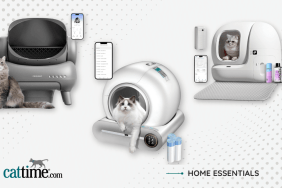Cats communicate with each other in various ways. One of the primary ways is through scent. Each cat’s urine and feces (stool) has a unique scent, so that when a cat urinates or defecates in a specific location, it is communicating with other cats that may come along later. This behavior is referred to as territory marking, and these marked spots “tell” other cats which cat has been to this spot and claimed that area or object as its territory. Another type of marking behavior, referred to as spraying, is distinguished by urinating on walls, furniture, or other upright surfaces.
Cats first begin marking territory as they become mature. For male cats this occurs around puberty, and for female cats it occurs around the time they go into estrus (heat) for the first time. When cats reach the age of puberty or estrus, they also become more likely to stray from home. This is called roaming. Cats will roam to find mates, to explore, and to mark their territory. Cats that are not spayed or neutered are more likely to mark territory and to roam than cats that are not neutered or spayed.
Symptoms and Types
Marking
- Cat urinates or defecates in a specific area that it has chosen
- Owner may not approve of the chosen area
- Urinating or defecating outside the litter box
- Urinating or defecating near doors or windows
- Can occur on a horizontal surface, such as the ground
- Can occur on vertical or upright surface, such as a wall or furniture (spraying)
Roaming
- Wandering away from home
Causes
- Can be normal behavior or cab be caused by another disease
- Hormones make cats more likely to mark and roam
- Cats learn some marking and roaming behavior
- Marking
- A need to define a territory
- A need to communicate with other cats
- Bladder infection
- Anxiety
- Diarrhea or constipation
- Diseases of the anal sacs (scent glands near the anus)
- Litter box not kept clean enough
- Preference for another kind of litter
- Stray outdoor cats near doors and windows (causing your cat to want to join them)
- Multiple cats in household
- Roaming
- A desire to explore territory
- A need to find a mate
- A need for more food
- A need to mark territory
- Separation anxiety
Diagnosis
You will need to provide a complete medical and behavioral history leading up to the onset of your cat’s marking and roaming behavior. Along with a thorough physical examination, your veterinarian will order the standard tests: a complete blood count, biochemical profile, and urinalysis. These tests will help your doctor to determine whether there is an underlying medical condition, such as a bladder infection, which might be causing your cat’s symptoms. Further tests may include a blood thyroid test to make sure that your cat’s thyroid level is normal, and fecal (stool) tests to rule out intestinal parasites or nutritional deficiency.
If the urine analysis shows that your cat has a bladder infection, your veterinarian may order a culture of the urine and x-rays of your cat’s bladder. The culture will show exactly what bacteria are causing the bladder infection, and x-ray images will show the presence of bladder stones, or other bladder problems, which might be causing the bladder infection.
If you have a female cat that is not spayed, your veterinarian may also do a vaginal cytology, a lab analysis of the cells in the vagina so that the stage of estrus (heat) she is in can be determined. If all of these tests return normal, your cat will be diagnosed with a behavioral problem.
Treatment
If a medical problem is found that is causing your cat to mark territory excessively, or roam away from home, this problem will be treated first. This alone may help decrease some of the behavior. If your cat is not spayed or neutered, your veterinarian will recommend spaying or neutering unless you have plans to breed your cat. This often helps to decrease roaming and marking behavior. If your cat has been diagnosed with a behavioral problem, your veterinarian will help to guide you through a plan to change that behavior (behavioral modification therapy). This plan will typically involve changes to your daily routine with your cat.
If you are having a problem with your cat roaming, you will need to keep it indoors all of the time. Provide toys and scratching posts to keep your cat busy while it is indoors, and as much as possible provide activities for your cat to spend its energy. If your cat is roaming because of separation anxiety or fear, your veterinarian will help you to come up with a behavior modification program to help your cat deal with its anxiety. In some cases, medication may be necessary to help your cat get over this problem and respond to the training.
If your cat has a persistent problem with marking, it may help to keep other animals away from your house and yard. If your cat is urinating or defecating outside of the litter box, you may need to change the type of litter that you use, or change the location of the litter box. Some cats prefer a finer grain of litter, and some cannot tolerate scented litters. Keeping the litter box clean on a daily basis is an important and often overlooked part of cat care. Cats do not like to step onto their own waste, and some will outright refuse to use a soiled litter box. Scooping urine and feces out of the litter box daily, and giving the box a thorough cleaning once a week will help your cat to feel comfortable using it. In the areas where your cat has urinated or defecated outside of the litter box, you will need to clean with a special cleaner that will remove the odors entirely, or your cat will return to those areas again and again. Even after cleaning, you should prevent your cat from going into those areas again. Another option is to use synthetic animal pheromones in the home to dissuade your cat from marking. These man-made versions of natural cat smells may cause your cat to think that the territory has already been marked and will not mark them again with its own urine. You veterinarian can tell you more about this and other options that will stop your cat’s marking behavior.
Living and Management
When you first begin behavioral modification therapy, your veterinarian will want to check your progress regularly. This is to address any issues that might have come up and to make sure that you and your cat are doing well with the planned therapy. If your cat is on medication for anxiety, you will need to return to the veterinarian’s office for follow-up complete blood counts and biochemistry levels to make sure the medication is not damaging any of your cat’s internal organs.
Because marking and roaming are normal cat behaviors, they may take some time to change and to stop entirely. Your dedication to the behavioral training will be the crucial determinant for a successful outcome. Keep in mind the importance of training your cat to be comfortable with staying indoors: when roaming, your cat could be in a fight or could be hit by a car, or it could be harmed or stolen by people who chance upon it.
The most common reasons people give their cats up to animal shelters is because of urinating or defecating in the home. The stress that this behavior brings into the home makes behavioral training essential. Keep in mind that patience and positive reinforcement go a long way as you train your cat to change its behavior for you.
Whatever treatment plan you and your veterinarian come up with, this is the plan that will need to be followed consistently for the rest of your cat’s life. This will keep your cat from returning to the inappropriate behavior. If your cat is being treated for anxiety, it may need to be on medication for a long time. Some cat’s can eventually be weaned off medication, while other’s anxiety issues may not be resolved as easily.
Prevention
Spaying female cats before their first heat cycle, and neutering male cats before they reach puberty can prevent a lot of inappropriate behaviors. Keep your cats indoors and provide plenty of toys to keep it active, and scoop all litter boxes daily, with thorough cleanings once a week.
This article originally appeared here on petmd.com.
This article courtesy of petmd.com.









